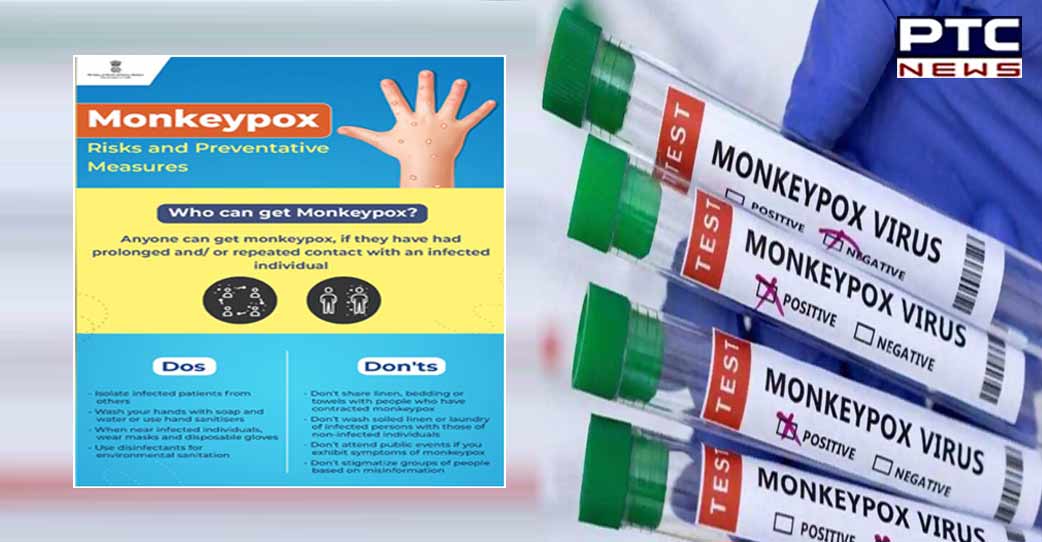

Centre releases guidelines to contain Monkeypox outbreak; details inside
New Delhi, August 3: Amid the surge in cases of Monkeypox in the country, Union Health Ministry on Wednesday released guidelines to contain the spread of the infection.

In an official notification, the health ministry informed that there was no reported case of the Monkeypox virus in India till May 31, 2022.
What is Monkeypox?
According to the World Health Organisation (WHO), monkeypox is a viral zoonotic infection caused by the Monkeypox virus. It spreads mostly from human contact.
Monkeypox (MPX) has symptoms similar to smallpox, although with less clinical severity. It was first discovered in 1958 in colonies of monkeys kept for research, hence the name 'Monkeypox.'
The first human case of Monkeypox infection was reported in the Democratic Republic of the Congo (DRC) in 1970.
Monkeypox is a self-limiting disease that typically lasts 2 to 4 weeks. Severe cases are more common in children and are associated with the extent of virus exposure, patient health status, and the nature of complications.
How to determine suspected cases?
A person of any age with a history of recent travel to affected countries who comes with an unexplained acute rash and one or more of the following signs or symptoms - Swollen lymph nodes, fever, headache, body pains and extreme weakness - can be deemed as a suspected case.
Common symptoms and signs
Early symptoms (0-5 days)
a. Fever
b. Lymphadenopathy
c. Headache, muscle aches, exhaustion
d. Chills and/or sweats
e. Sore throat and cough
Also Read | Monkeypox scare: Health Minister Mandaviya urges people not to panic
Skin involvement (rash)
a. Usually begins within 1-3 days of fever onset, lasting for around 2-4 weeks
b. Deep-seated, well-circumscribed and often develop umbilication
c. Lesions are often described as painful until the healing phase when they become itchy (in the crust stage)
The Ministry also established guidelines for properly monitoring anyone who had contact with the affected person.
a) Contacts should be monitored at least daily for the onset of signs/symptoms for a period of 21 days (as per case definition above) from the last contact with a patient or their contaminated materials during the infectious period. In case of occurrence of fever clinical/lab evaluation is warranted.
b) Asymptomatic contacts should not donate blood, cells, tissue, organs or semen while they are under surveillance.
c) Pre-school children may be excluded from daycare, nursery or other group settings.
d) Health workers who have unprotected exposures to patients with monkeypox or possibly contaminated materials do not need to be excluded from work duty if asymptomatic but should undergo active surveillance for symptoms for 21 days.
Measures to prevent monkeypox infection
1. Avoid contact with any materials, such as bedding, that have been in contact with an infected person.
2. Isolate infected patients.
3. Practice good hand hygiene after coming in contact with infected animals or humans. For example, wash your hands with soap and water or use an alcohol-based hand sanitiser.
4. When taking care of patients, wear proper personal protective equipment (PPE).
5. Rapid identification and surveillance of new cases are essential for outbreak containment. Close contact with infected people is a critical risk factor for monkeypox virus infection. Health workers and household members are more vulnerable to infection.
6. Health professionals who care for patients with suspected or confirmed monkeypox virus infection, or who handle specimens from them, should follow standard infection control precautions. Samples collected from people and animals suspected of having monkeypox virus infection should be handled by trained personnel working in properly equipped laboratories. Patient specimens must be safely packed for transport using triple packaging in accordance with WHO guidelines for infectious substance transport.
Infection Prevention and Control (IPC)
When a patient has a fever and a vesicular/pustular rash - standard, contact, and droplet precautions should be used in all healthcare settings. Furthermore, because of the theoretical possibility of Monkeypox virus transmission by air, airborne precautions should be taken as specified by risk assessment.
Also Read| CWG 2022: Indian Women’s Lawn Bowls Team script history by clinching Gold
-PTC News
